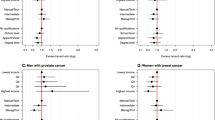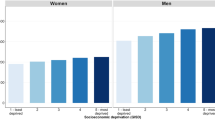Abstract
Objective
To examine associations between area and individual socio-economic characteristics and premature cancer mortality using multilevel analysis.
Methods
We modeled cancer mortality among 25–64-year-old men and women (n = 16,340) between 1998 and 2000 in Australia. Socio-economic characteristics of Statistical Local Areas (n = 1,317) were measured using an Index of Relative Socio-economic Disadvantage (quintiles), and individual socio-economic position was measured by occupation (professionals, white and blue collar).
Results
After adjustment for within-area variation in age and occupation, the probability of premature cancer mortality was highest in the most disadvantaged areas for all-cancer mortality for men (RR 1.48 95% CI 1.35–1.63) and women (RR 1.30 95% CI 1.18–1.43) and for lung cancer mortality for men (1.91 95% CI 1.63–2.25) and women (1.51 95% CI 1.04–2.18).
Men in blue collar occupations had a higher rate of cancer mortality (RR 1.57 95% CI 1.50–1.65) and lung cancer mortality (RR 2.31 95 % CI 2.09–2.56), whereas men in white collar occupations had a lower all-cancer mortality rate (RR 0.78 95% CI 0.72–0.85). Compared with professionals, women in white collar occupations had an all-cancer mortality rate that was lower (RR 0.85 95% CI 0.80–0.90). When deaths from breast cancer were excluded, women in blue collar occupations had a significantly higher all-cancer mortality rate than professionals (RR 1.12 95% CI 1.02–1.22).
Conclusions
Area disadvantage and individual socio-economic position were independently associated with premature cancer mortality, suggesting that interventions to reduce inequalities should focus on places and people.
Similar content being viewed by others
References
Faggiano F, Lemma P, Costa G, Gnavi R, Pagnanelli F (1995) Cancer mortality by educational level in Italy. Cancer Causes and Control 6(4):311–320
Marshall B, Chevalier A, Garillon C, Goldberg M, Coing F (1999) Socioeconomic status, social mobility and cancer occurrence during working life: a case-control study among French Electricity and Gas Workers. Cancer Causes and Control 10(6):495–502
Martikainen P (1995) Mortality and socio-economic status among Finnish women. Population Studies 49(1):71–90
Greenwald HP, Borgotta EF, McCorkle R, Polissar N (1996) Explaining reduced cancer survival among the disadvantaged. Milbank Q 74(2):215–238
Hall S, Holman CD, Platell C, Shneier H, Threlfall T, Semmens J (2005) Colorectal cancer surgical care and survival: do private health insurance, socio-economic and locational status make a difference? ANZ J Surg 75(11):929–35
Hall S, Holman CD, Sheiner H, Hendrie D (2004) The influence of socio-economic and locational disadvantage on survival after a diagnosis of lung or breast cancer in Western Australia. J Health Serv Res Policy 9(Supplement 2):10
Hall S, Holman CD, Wisniewski Z, Semmens J (2005) Prostate cancer: socio-economic, geographical and private-health insurance effects on care and survival. BJU Int 95(1):51–8
Kravdal O (2000) Social inequalties in cancer survival. Popul Stud 54(1):1–18
Mandelblatt J, Andrews H, Kao R, Wallace R, Kerner J (1996) The late-stage diagnosis of colorectal cancer: demographic and socio-economic factors. Am J Public Health 86(12):1794–7
Vinnakota S, Lam NSN (2006) Socio-economic inequality of cancer mortality in the United States: a spatial data mining approach. Int J Health Geogr 15 Feb 2006(5): 9
U.S. Cancer Statistics Working Group (2005) United States cancer statistics: 2002 incidence and mortality. U.S. Department of Health and Human Services, Centres for Disease Control and Prevention, National Cancer Institute, Atlanta
Speigel D, Bloom JR, Kraemer HC, Gottheil E (1989) Effect of psychosocial treatment on survival of patients with metastatic breast cancer. Lancet 2:888–891
Singh GK, A. MB, Hankey BF, Edwards BK (2003) Area socioeconomic variations in U.S. cancer incidence, mortality, stage, treatment and survival, 1975–1999. NIH publication no. 04-5417. National Cancer Institute, Bethesda, MD
Australian Institute of Health and Welfare and Australasian Association of Cancer Registries (2007) Cancer in Australia: an overview, 2006. Cancer series no. 37. AIHW, Canberra
Draper G, Turrell G, Oldenburg B (2004) Health inequalities in Australia: mortality. Health Inequalities Monitoring Series No. 1 AIHW cat. no. PHE 55. Queensland University of Technology and the Australian Institute of Health and Welfare, Canberra
Piantadosi S, Byar D, Green S (1988) The ecological fallacy. Am J Epidemiol 127:893–904
Robert S, Strombom I, Trentham-Dietz A, Hampton J, McElroy J, Newcomb P, Remington P (2004) Socioeconomic risk factors for breast cancer: distinguishing individual- and community-level effects. Epidemiology 15(4):442–450
Steenland K, Henley J, Calle E, Thun M (2004) Individual- and area-level socioeconomic status variables as predictors in mortality in a cohort of 179,383 persons. Am J Epidemiol 159(11):1047–1056
Waitzman N, Smith K (1998) Phantom of the area: poverty-area residence and mortality in the United States. Am J Public Health 88:973–976
Subramanian S, Duncan C, Jones K (2001) Multilevel perspectives on modeling census data. Environ Plan A 33:399–417
Harvard Center for Cancer Prevention (1996) Harvard Reports on Cancer Prevention: human causes of cancer. Cancer Causes Control 7(Supplement 1):533–535
Australian Institute of Health, Welfare (2004) Cancer in Australia 2001. Cancer series number 28. Australian Institute of Health and Welfare, Canberra
Smith D, Taylor R, Coates M (1996) Socioeconomic differentials in cancer incidence and mortality in urban New South Wales, 1987–1991. Aust N Z J Public Health 20(2):129–137
Australian Institute of Health, Welfare & National Breast Cancer Centre (2006) Breast cancer in Australia: an overview, 2006. Cancer series no. 34. AIHW, Canberra
Australian Bureau of Statistics (1996) Statistical geography: volume 1 Australian Standard Geographical Classification (ASGC). Australian Government Publishing Service, Canberra
Magliano D, Liew D, Pater H, Kirby A, Hunt D, Simes J, Sundararajan V, Tonkin A (2003) Accuracy of the Australian National Death Index: comparison with adjudicated fatal outcomes among Australian participants in the Long-term Intervention with Pravastatin in Ischaemic Disease (LIPID) study. Aust N Z J Public Health 27(6):649–53
Australian Bureau of Statistics (1997) Australian Standard Classification of Occupations, 2nd edn. Australian Government Publishing Service, Canberra
Australian Bureau of Statistics (1998) Socioeconomic index for areas. Australian Government Publishing Service, Canberra
Bennett S (1996) Socioeconomic inequality in coronary heart disease and stroke mortality among Australian men. Int J Epidemiol 25:266–75
Burton N, Turrell G (2000) Occupation, hours worked, and leisure-time physical activity. Prev Med 31:673–81
Goldstein H (2003) Multilevel statistical models. Arnold, London
Rasbash J, Browne W, Goldstein H (2000) A user’s guide to MLwiN version 2.1. Institute of Education, The University of London, London
Turrell G, Mathers C (2000) Socio-economic status and health in Australia. Med J Aust 172:434–438
Blais S, Dejardin O, Boutreaux S, Launoy G (2006) Social determinants of access to reference care centres for patients with colorectal cancer—a multilevel analysis. Eur J Cancer 42(17):3041–8
Parsons M, Askland K (2007) Cancer of the colorectum in Maine, 1995–1998: determinants of stage at diagnosis in a rural state. J Rural Health 23(1):25–32
The World Health Organisation. (2002) The world health report: reducing risks, promoting healthy life. WHO, Geneva
Kavanagh A, Goller J, King T, Jolley D, Crawford D, Turrell G (2005) Urban area disadvantage and physical activity: a multilevel study in Melbourne, Australia. J Epidemiol Community Health 59:934–940
van Lenthe F, Brug J, Mackenbach J (2005) Neighbourhood inequalities in physical inactivity: the role of neighbourhood attractiveness, proximity to local facilities and safety in the Netherlands. Soc Sci Med 60(4):763–775
Glass T, Rasmussen M, Schwartz M (2006) Neighbourhoods and obesity in older adults. The Baltimore memory study. Am J Prev Med 31(6):455–463
Shaw H, McGovern V, Milton G, Farago G (1981) Cutaneous malignant melanoma: occupational and prognosis. Med J Aust 1(1):37–8
Schwartz K, Crossley-May H, Vigneau F, Brown K, Banerjee M (2003) Race, socioeconomic status and stage at diagnosis for five common malignancies. Cancer Causes Control 14(8):761–6
Australian Institute of Health, Welfare (2006) Australia’s health 2006. AIHW cat. no. AUS 73. AIHW, Canberra
Morris M, Iacopetta B, Platell C (2007) Comparing survival outcomes for patients with colorectal cancer treated in public and private hospitals. Med J Aust 186(6):296–300
Turrell G, Kavanagh A, Draper G, Subramanian SV (2007) Do places affect the probability of death in Australia? A multilevel study of area-level disadvantage, individual-level socioeconomic position and all-cause mortality, 1998–2000. J Epidemiol Community Health 61(1):13–19
Blakely T, Fawcett J (2005) Bias measuring mortality gradients by occupational class in New Zealand. N Z Med J 118:U1253
Turrell G, Hewitt B, Patterson C (2003) Measuring socioeconomic position in dietary research: is choice of socioeconomic indicator important? Public Health Nutr 6:191–200
Boyle MH, Wilms JD (1999) Place effects for areas defined by administrative boundaries. Am J Epidemiol 149:577–585
Curtis S, Jones I (1998) Is there a place for geography in the analysis of health inequality? Sociol Health Illn 20:645–672
Martikainen P, Valkonen T (1999) Bias related to the exclusion of the economically inactive in studies on social class differences in mortality. Int J Epidemiol 28:899–904
Harper S, Lynch J (2005) Methods for measuring cancer disparities: using data relevant to Health People 2010 cancer-related objectives. NCI cancer surveillance monograph series. National Cancer Institute, US Department of Health and Human Services, National Institute of Health, Washington, DC
Acknowledgements
R. Bentley is supported by a National Health and Medical Research Council Capacity Building Grant in Population. Health Research (Australian Health Inequalities: A program addressing social and economic determinants of health). S. V. Subramanian is supported by the National Institutes of Health Career Development Award (NHLBI 1 K25 HL081275). Gavin Turrell is supported by a National Health and Medical Research Council Senior Research Fellowship (No. 390109).
Author information
Authors and Affiliations
Corresponding author
Rights and permissions
About this article
Cite this article
Bentley, R., Kavanagh, A.M., Subramanian, S. et al. Area disadvantage, individual socio-economic position, and premature cancer mortality in Australia 1998 to 2000: a multilevel analysis. Cancer Causes Control 19, 183–193 (2008). https://doi.org/10.1007/s10552-007-9084-7
Received:
Accepted:
Published:
Issue Date:
DOI: https://doi.org/10.1007/s10552-007-9084-7




